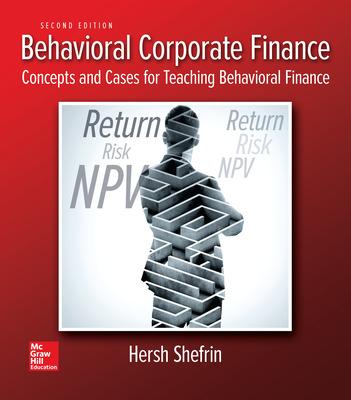Discuss any psychological phenomena that you per- ceive to have been at work in the S&L crisis,
Question:
Discuss any psychological phenomena that you per- ceive to have been at work in the S&L crisis, empha- sizing the implicit option features described in the case. Relate these phenomena to the issues described in the chapter text.
In essence, a savings and loan (S&L) is a firm whose projects are long-term mortgages, whose customers are homeowners that mortgage their homes, and whose debt holders are depositors. In a typical project, an S&L will invest in a 30-year mortgage, where the cash flows from the project are mortgage payments.
In the 1970s, market traditions and pressures led S&Ls to finance their projects by relying heavily on short-term debt, borrowing from depositors. Nominal capital requirements were that an S&L’s equity be no less than 6 percent of its liabilities, leading S&Ls to have debt-to-capital ratios of ap- proximately 95 percent. Not surprisingly, the S&L industry was among the most highly leveraged in the United States.15 S&Ls borrow short-term, but invest long-term. Notably, the prices of long-term bonds are more sensitive to interest rate changes than are short-term bonds. Therefore the assets of S&Ls are riskier than their liabilities.
When the interest rate is i, the present value of a one- year zero-coupon bond that pays $1 is 1∕(1 + i). In con- trast, the present value of a consol bond that pays $1 every year into perpetuity is 1∕i. By comparing the two present- value formulas, it is easy to see that when the interest rate rises, the percentage decline in price is greater for the long-term bond than for the short-term bond.
In the 1970s, S&Ls with short-term liabilities and long-term assets exposed themselves to risks associated with increases in interest rates. The gap between long- term mortgage rates and short-term CD rates declined precipitously. As the difference between mortgage rates and short-term rates closed in the mid-to-late 1970s, the market value of S&L liabilities grew relative to the market value of S&L assets, to the point where the industry be- came insolvent. However, accounting rules did not require the recognition of market value losses in mortgages caused by interest rate increases.
S&Ls could have ended their (losing) bets on inter- est rate risk by selling their mortgages and reinvesting in short-term assets or by hedging. However, either action would have required S&Ls to recognize, for accounting purposes, that they were insolvent. Instead, they gam- bled by continuing their overall exposure to interest rate risk and by investing in assets that featured high credit risk. Interest rates dropped sharply after 1982. The high- risk gamble did pay off for many S&Ls. Yet in 1983, 35 percent of institutions still sustained losses. By gen- erally accepted accounting principles (GAAP) 9 percent of all S&Ls (representing 10 percent of industry assets) remained insolvent, meaning that the market value of their liabilities exceeded the market value of their assets. In most corporations, it is debt holders who confer a put option on equity holders. However, in the case of S&Ls, the debt holders....
Perpetuity refers to payments that are made without an end or maturity date. A perpetuity is classified as an annuity, which is something that earns a dividend or receives a payment at a regularly scheduled interval, generally yearly. So, how...
Step by Step Answer:

Behavioral Corporate Finance Concepts And Cases For Teaching Behavioral Finance
ISBN: 9781259277207
2nd Edition
Authors: Hersh Shefrin





